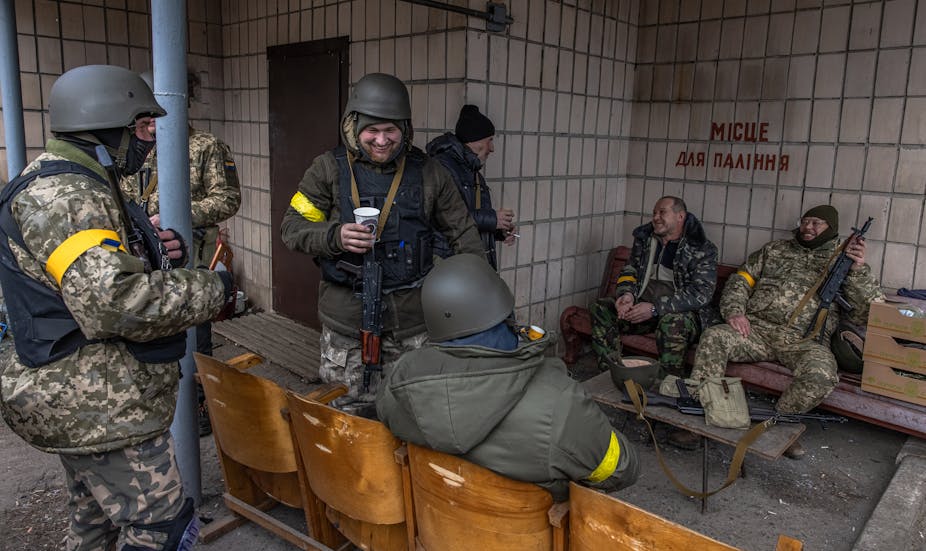Shortly after the Russian invasion, Ukrainian President Volodymyr Zelensky invited volunteers from around the world to come and help defend Ukraine. Some 3,000 US citizens have reportedly volunteered. And in early March, Ukrainian authorities announced they are setting up an international brigade. Zelensky has said that 16,000 foreign volunteers are coming to fight for the Ukrainian cause.
UK foreign secretary Liz Truss openly supported the idea of Britons going to Ukraine to fight. Top defence officials have contradicted this, saying it is “unlawful as well as unhelpful”.
Historically, states have recruited foreign war volunteers for one of three reasons. Either they have manpower shortages, they want recruits with specific military training to improve the quality of their armed forces, or they want the influence foreign volunteers could have on international politics. Ukraine is not short of domestic recruits, and it does not need foreign volunteers to build its air force from scratch as Poland did in 1920 or Israel in 1948.
Zelensky clearly wants to internationalise the conflict. As Ukraine is fighting for its survival against a militarily superior foe, he has every reason to do so. But since Nato is not poised to join the war at this stage, Zelensky is hoping to goad friendly governments into increasing their commitment. It is possible that he sees involving foreign citizens as one way of further tethering the international community to Ukraine’s struggle.
From the host’s perspective, foreign volunteers can be an excellent propaganda tool for both domestic and international needs. In Finland’s winter war against the Soviet Union (1939-40), the knowledge that outsiders were willing to fight alongside Finnish troops boosted local morale.
The Finnish high command valued the foreign volunteers to such an extent that even during the desperate days of March 1940, when the situation on the front line was critical, foreign volunteers were not used as cannon fodder. In fact, most volunteers did not have time to see combat and the Swedes, who did, were placed on the quietest sector of the front.
After the war ended, the Finnish government was keen to keep the British volunteers in country and in uniform. The hope was that their presence would maintain Britain’s interest in that corner of the Baltic.
Foreign volunteers also attract media attention, especially in the countries they come from. Volunteers view themselves as somehow representing their own country, and often hope to see their government follow their example by intervening in the conflict. In Ukraine, representing the west seems to be a recurring motive among would-be volunteers. “Nato can’t get involved,” a former policeman said, “but we can.”
Is it legal?
Regardless of motivation, the question of the legality of fighting alongside another country’s armed forces remains. Truss’ comments confounded legal experts, with former attorney general Dominic Grieve pointing out that any British citizen travelling to fight in Ukraine would be in breach of the 1870 Foreign Enlistment Act. However, the foreign secretary has historical precedent on her side.
The British government has a long history of applying the Foreign Enlistment Act very selectively. In conflicts where a foreign cause was deemed worthy, the British government either turned a blind eye to the departure of volunteers or even tacitly assisted such endeavours.

Most strikingly, senior government officials in London supported the Finnish cause in the winter war to such an extent that they facilitated the departure of 228 British volunteers who, equipped by the British army, sailed first to Norway in February 1940. The volunteers’ wages came from donations the British public had sent to the Finnish Aid Bureau. This bureau included very senior British politicians such as Lord Balfour and Leo Amery. It routinely communicated with the war cabinet and received the cooperation of the British military machine.
The British government was not alone in its willingness to bend its foreign enlistment legislation for the right kind of cause. In January 1940, with the Finnish cause in mind, US President Roosevelt announced that as long as Americans did not take an oath of allegiance, they would not lose their citizenship even if they volunteered to join a foreign army.
In most cases, states don’t want to see their citizens volunteer to participate in foreign conflicts. British volunteers seeking to fight in the Spanish civil war were warned in 1937 that they would be breaching the Foreign Enlistment Act. More recently, during the Syrian civil war, the British government took an even more hardline approach.
When the government is sympathetic towards one side in a conflict, and that conflict enjoys very broad public support as Finland did in 1940 and Ukraine does today, the government can derive some benefits from enabling the departure of volunteers wishing to fight. Chief among these is the ability to deny any responsibility should the opposing power in the conflict protest –- this is what Sweden did when the Soviet Union complained about recruiting for Finland during the winter war.
As in the winter war, the willingness of international volunteers to enlist and fight for Ukraine, and of several states to tolerate their departure, are an indication of the popularity of Kyiv’s cause.

